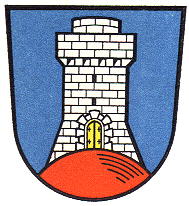Büdingen (kreis): Difference between revisions
Jump to navigation
Jump to search
Knorrepoes (talk | contribs) (Created page with '{|width="100%" style="color:black; background-color:#ffffcc;" |width="15%"|50 px|left |width="70%" align="center" |'''Heraldry of the World<br/>Civic heraldr…') |
Knorrepoes (talk | contribs) No edit summary |
||
| Line 16: | Line 16: | ||
The arms were granted on June 16, 1952. | The arms were granted on June 16, 1952. | ||
The mountain in the base of the arms symbolises the Vogelsberg area, the highest point in the district. The tower is the former tower on the Vogelsberg. The tower also symbolises the city of [[ | The mountain in the base of the arms symbolises the Vogelsberg area, the highest point in the district. The tower is the former tower on the Vogelsberg. The tower also symbolises the city of [[Büdingen]], as the oldest seals of the city also showed a tower. | ||
[[Literature]] : Stadler, K. : Deutsche Wappen - Bundesrepublik Deutschland. Angelsachsen Verlag, 1964-1971, 8 volumes. | [[Literature]] : Stadler, K. : Deutsche Wappen - Bundesrepublik Deutschland. Angelsachsen Verlag, 1964-1971, 8 volumes. | ||
Revision as of 11:17, 24 December 2010
| Heraldry of the World Civic heraldry of Germany - Deutsche Wappen (Gemeindewappen/Kreiswappen) |
BÜDINGEN (BÜD)
State : Hessen
Additions : 1936 Schotten (partly)
Incorporated into : 1972 Wetteraukreis
Origin/meaning :
The arms were granted on June 16, 1952.
The mountain in the base of the arms symbolises the Vogelsberg area, the highest point in the district. The tower is the former tower on the Vogelsberg. The tower also symbolises the city of Büdingen, as the oldest seals of the city also showed a tower.
Literature : Stadler, K. : Deutsche Wappen - Bundesrepublik Deutschland. Angelsachsen Verlag, 1964-1971, 8 volumes.

